This is what oak foliage is supposed to look like in late summer, photosynthesising like mad, with a crop of healthy acorns developing. But years certainly vary: every twig may be bearing acorns one year while the following year it's a serious hunt to find any at all. It is not known why this should be, nor how it is controlled: oak 'mast years' occur irregularly with only dubious correlations with climatic, soil and pest or disease factors.
This article discusses some aspects.
But our oak trees are subject to a whole range of maladies; some of them serious, some curious; some regular features, others varying in intensity from year to year. Though it is unlikely to be a totally comprehensive list, many of them feature below, not in any order of importance. Fortunately we seem to be avoiding the most serious oak diseases as featured on the
Forestry Commission listing.
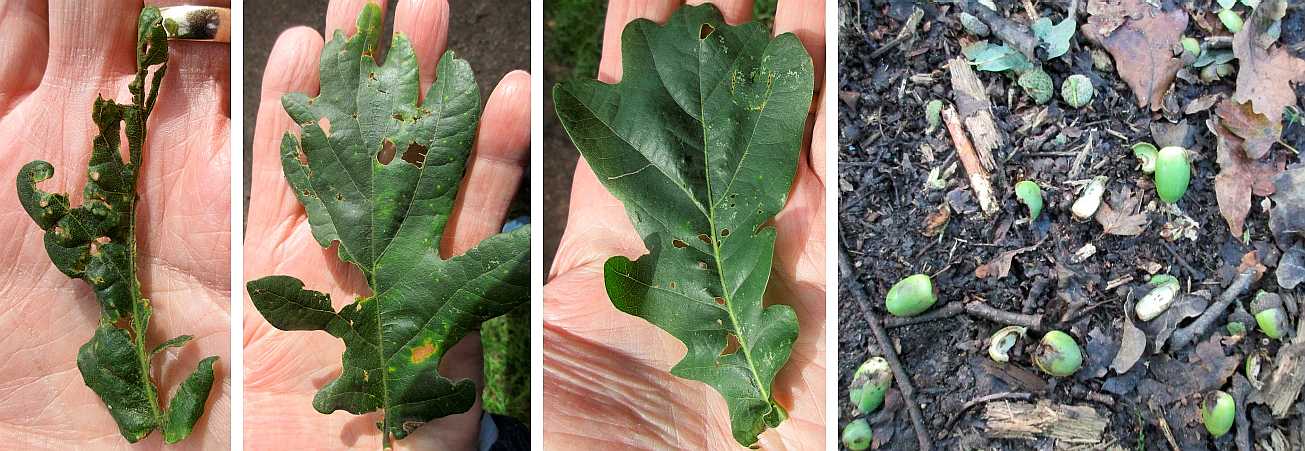
Of course, everything organic is a source of food for
something so it comes as no surprise to find that oak leaves, though basically unpalatable to most animal species, can be found significantly eaten away. Caterpillars tend to work systematically from an exposed edge: other critters may select a random spot for lunch. Then there are the squirrels: they are certainly wasteful in oak mast years.

There are reputed to be thirty or more types of gall wasps that lay eggs in oak tree tissue, causing the tree to produce anomalous growth resulting in these and other 'oakapples' and 'Knoppers'. The spring-time infestations (left) result from egg-laying in leaf buds. More conventional, compact, spherical
Biorhiza pallida oakapples and
Andricus kollari oak marble galls appear later in the season.
 Andricus quercuscalicis
Andricus quercuscalicis wasps make use of developing acorns: the distorted results are known as a 'knopper galls'. They fall before healthy acorns, and may actually be harvested as an ingredient for use in homeopathy.

These cushion-pad growths are on the undersides of oak leaves, never the upper side. Curiously, they can be flipped off with a fingernail, leaving just a minute hole through the leaf. Believe it or not, they too are galls despite their diminutive size: they are known as 'common spangle galls', arising from the activities of
Neuroterus quercusbaccarum wasps. (The inclusion of the green insect and of the white object in the extreme lower right corner were accidental and totally insignificant.)

Similarly, these ring growths, again on the undersides of leaves, are again galls, 'silk button spangle galls', caused in this case by
Neuroterus numismalis. The accidental spider in the left picture was certainly insignificant, but the centre picture's white growths could possibly be more serious so they appear again further down the page. The right-hand picture simply demonstrates that one growth type does not protect against the other.

Even more unbelievable perhaps, these 'artichoke' growths are yet another form of gall, each one marking where an
Andricus fecundator egg had earlier been inserted into a fresh young oak bud. These beasties have a curious life history too. These galls host female flies only, and they will be inactive until the following spring: they will then attack the male oak catkins, causing yet more galls but hosting flies of both sexes this time.

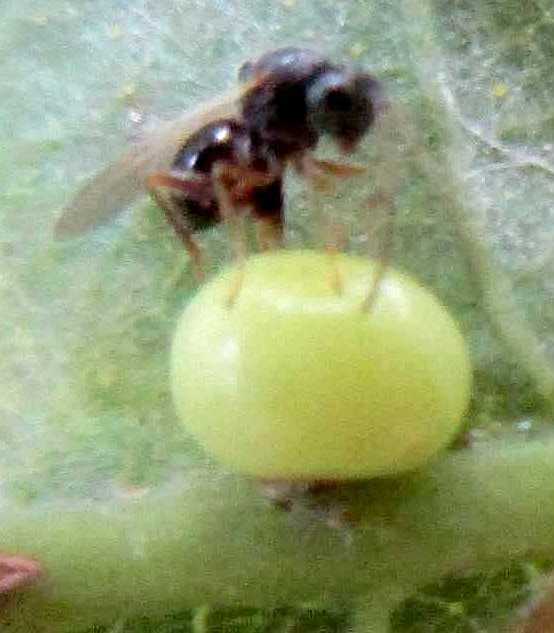
Much smaller, but at least looking more believably like conventional galls,
Neuroterus anthracinus mini-wasps give rise to these 'oyster gall' globules of almost any colour but always located adjacent to a mid-rib or main vein, rarely on the topside of the leaf. It looks as if some of them get chewed by other denizens of the oak foliage.
But the
Neuroterus anthracinus wasps don't always have it all their own way. While photographing specimens a fly was spotted, ignoring everything in its concentrated examination of an oyster gall. It was later identified as a Chalcoid parasitic wasp, probably a
Mesopolobus species. They lay their eggs into the body of the developing larva in the gall, and as the
Neuroterus larva develops so too does the
Mesopolobus larva inside its host by slowly eating it from the inside. Eventually
Mesopolobus kills the host, pupates, and leaves the gall as an adult wasp.
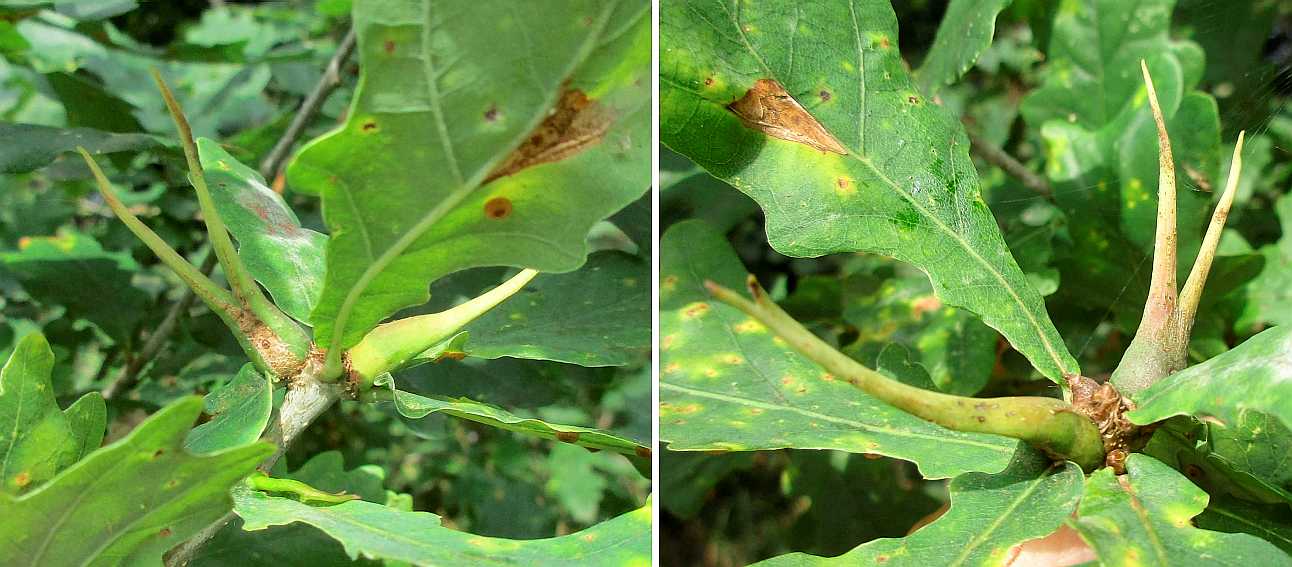
Less common (or less easily spotted) the curious spiky galls formed by
Andricus aries have been named 'ram's horn galls' for no very obvious reason: they look more like Highland cattle horns. They are relative newcomers, unkown in the UK before 1997.

Certainly not a conventional gall this time, according to a translation (from Swedish) of the only relevant website: "
Macrodiplosis dryobia. These grids are located at the top of the leaf flip. The folded part of the blade becomes slightly thickened and bent down. It is covered with a prickly pattern (which may be difficult to see in autumn when the leaves have become brown). Inside the folded leaf there are often 3-5 larvae. The larvae live in the leaf until June to July, when they plummet and fall to the ground."

Curious pathology! Some kind of leaf mining moth larva, possibly of a
Phyllonorycter species, is responsible for these mosaic-like patterns, evidently limited in some way by the vein structure of the leaf. It eats out the leaf's middle tissue ('mesophyll'), leaving the upper and lower epidermis layers untouched.

These blister-like features are due to a different class of leaf miners. In each of the two examples the top surface is shown on the left, the underleaf on the right. Experts opt for the larger one being due to
Dyseriocrania subpurpurella, and the smaller to
Ectoedemia subbimaculella.
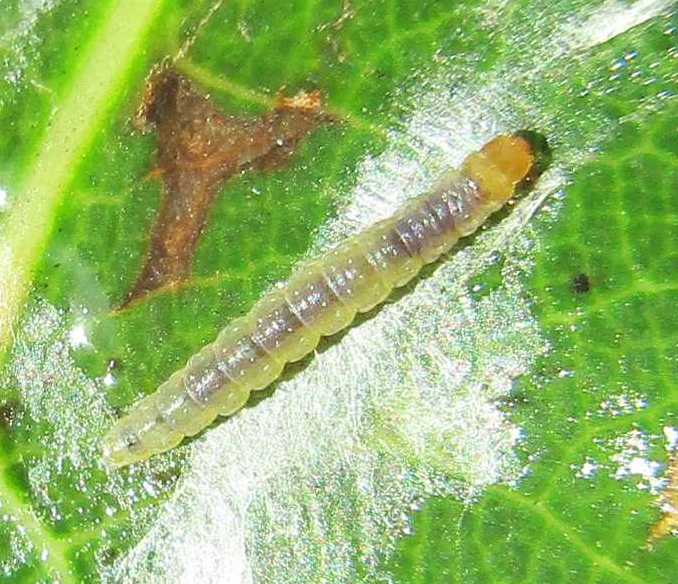 | This critter was discovered when a folded oak leaf was peeled apart one late autumn day. Identified as a Caloptilia miner, the assurance was given that "they are rather benign little things and don’t cause much upset to the tree as a whole." |

Some clear criminal evidence. The long thin mines with dark material inside (frass, insect faeces) are from another moth, this time a
Stigmella species.

Just as your roses or other garden treasures may suffer from mildew, so our oak trees are subject to a powdery mildew caused by the fungus
Erysiphe alphitoides (also known as
Microsphaera alphitoides). The whitening can intensify and spread, obscuring the green altogether, especially in hot, dry weather. Terminal twigs may be killed off but the disease is unlikely to have any devastating effect on the tree as a whole.

Of course mildew is a type of fungus, but there are evidently other rotting organisms ready to attack the plant or to make use of any other form of damage to gain a hold. (Again, top left, underleaf right.)
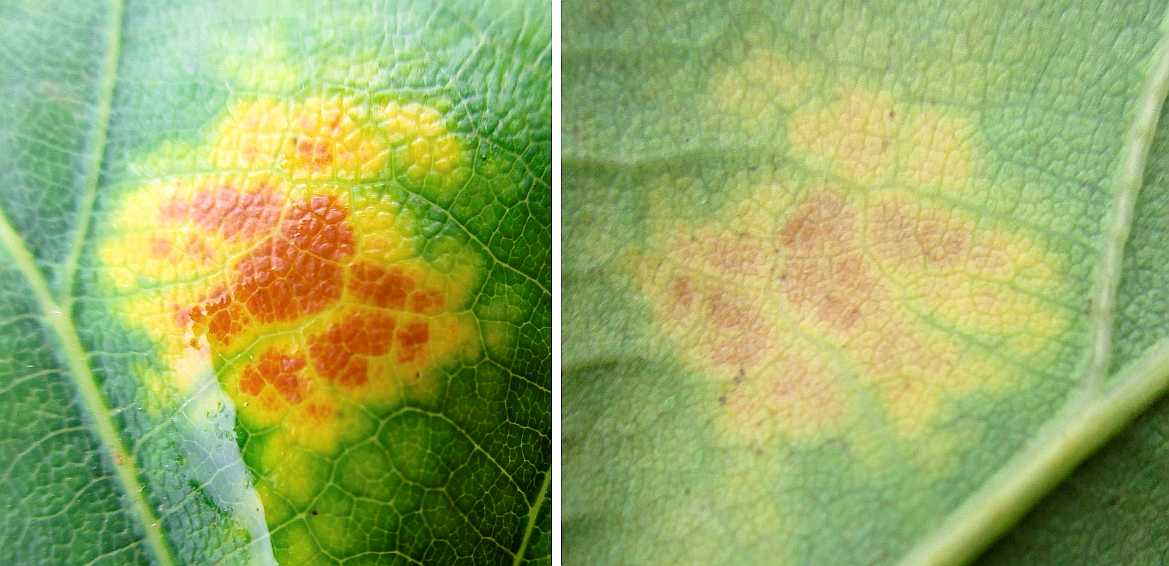
Virtually certainly the leaf's reaction to yet another kind of fungus. (Again, top left, underleaf right.)

This whitish patterning seems to extend through to both sides of the leaves. The black marks along the main veins could possibly be causally connected.

This white patterning seems to be superficial on the lower surface of the leaf, but the top side (centre picture) is slightly discoloured too.

The enlarged picture shows what look like spider threads. So is the white object a spider egg or eggs? - harmless to the host?
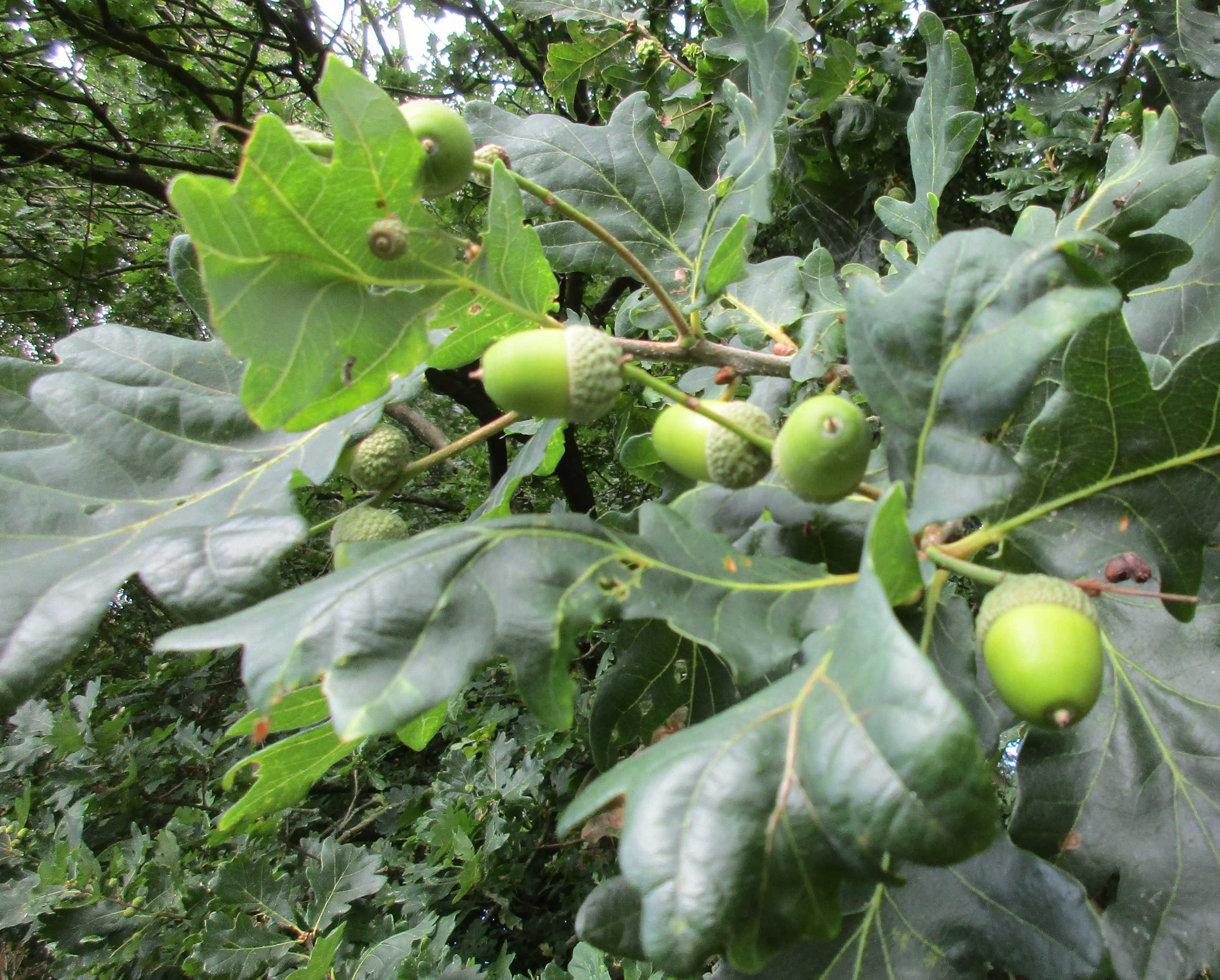








 Much smaller, but at least looking more believably like conventional galls, Neuroterus anthracinus mini-wasps give rise to these 'oyster gall' globules of almost any colour but always located adjacent to a mid-rib or main vein, rarely on the topside of the leaf. It looks as if some of them get chewed by other denizens of the oak foliage.
Much smaller, but at least looking more believably like conventional galls, Neuroterus anthracinus mini-wasps give rise to these 'oyster gall' globules of almost any colour but always located adjacent to a mid-rib or main vein, rarely on the topside of the leaf. It looks as if some of them get chewed by other denizens of the oak foliage. Less common (or less easily spotted) the curious spiky galls formed by Andricus aries have been named 'ram's horn galls' for no very obvious reason: they look more like Highland cattle horns. They are relative newcomers, unkown in the UK before 1997.
Less common (or less easily spotted) the curious spiky galls formed by Andricus aries have been named 'ram's horn galls' for no very obvious reason: they look more like Highland cattle horns. They are relative newcomers, unkown in the UK before 1997.






 Virtually certainly the leaf's reaction to yet another kind of fungus. (Again, top left, underleaf right.)
Virtually certainly the leaf's reaction to yet another kind of fungus. (Again, top left, underleaf right.)

